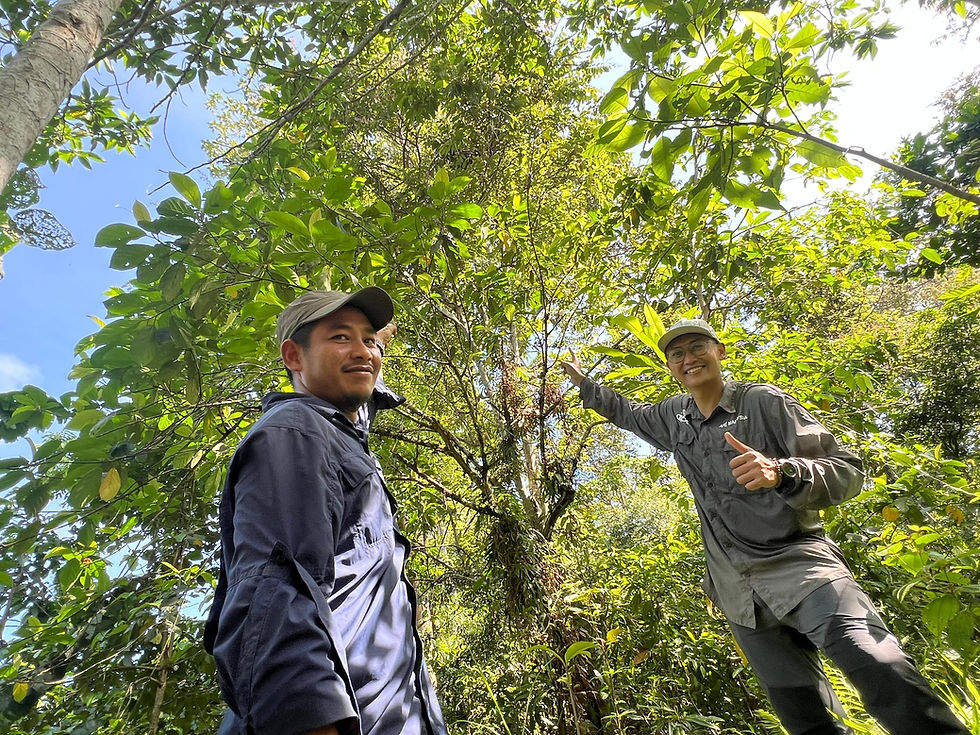Sara's Commitment to Conservation
- azaorangutansafe
- Nov 29, 2022
- 3 min read
Written by Kansas City Zoo
Sara Markway has worked at the K

ansas City Zoo for more than five years. She is currently a Tiger Trail primary zookeeper. One of her proudest accomplishments at the zoo was making nestbox modifications that resulted in our rhinoceros hornbill breeding pair successfully rearing two daughters.
Sara recently traveled to Lower Kinabatangan River in Sabah, Borneo, Malaysia, to work on the KC Zoo conservation project CREATE-Corridor Restoration for Animals Threatened and Endangered. The CREATE project aims to restore important wildlife corridors to fragmented parts of rainforest so there will be a safe and secure passageway for the Bornean orangutans and other wildlife species.
The Kansas City Zoo currently has four restoration sites totaling roughly 30 acres. There, more than 6,000 young saplings have been planted and maintained in order to restore the canopy of the rainforest. Tree species selected for planting are fruit-bearing [as a food source for native wildlife). fast-growing/ pioneer [native). and/or water tolerant since some of the areas are waterlogged.
Because these areas are exposed to a lot of sunlight, weeds grow rapidly and try to choke out the new saplings. Sara said her main job the first three days was to maintain sites that had already been planted by cutting away all the weeds that had grown around and over the saplings. Saplings must be maintained for about two years before they are large enough that the weed growth can no longer negatively affect them.
The other three days, the team planted new saplings on two of the KC Zoo reforestation sites. Along with planting and maintaining saplings, they collected data on how previously planted saplings were growing. That included recording tree height, trunk thickness, new leaf growth and any damage made by animals. This data is crucial in future planting efforts because it shows what species of trees are thriving in certain soil and sunlight conditions.

Additionally, Sara helped collect data from the camera traps that were set up around the reforestation sites to see what species were coming into the area.
"We were able to see a sambar deer on the camera trap footage, which was very exciting because they have never seen on video in that area before," Sara said.
However, Sara said the most exciting part of her trip was the opportunity to help install a hornbill nest box close to one of the KC Zoo reforestation sites. The Kinabatangan is one of Saba h's best places to observe horn bills. All eight species of hornbills in Borneo can be seen here, with six of the eight horn bill species frequenting the area regularly.

Sabah is one of the richest areas in the world for the dipterocarp tree species that can grow to be more than 250 feet tall. This made them very desirable to the logging industry. Due to heavy logging activity in the 70's and 80s, most of the large hardwoods [dipterocarps) were cut down. As a result, the majority of the Lower Kinabatangan River area is now made up of secondary rainforest and lacks old-growth trees.
Larger species such as the rhinoceros horn bill and helmeted hornbill tend to choose bigger, taller trees for their nesting cavity sites. Hornbills show strong loyalty to their nest sites, with breeding pairs returning to the same cavity year after year. It has been recorded over the years that these horn bill species were coming into the Lower Kinabatangan River area to feed but weren't staying to nest because of the lack of large tree cavities. To help fill the need for more suitable nesting cavities, local conservationists have decided to install nest boxes in the area. As a measure to entice the larger hornbill species to nest in the area, nest boxes were attached to trees at least 20 meters high and positioned in a way that no direct sunlight can shine through the entrance.
"The nest box that I helped put up was attached to the tree 22 meters up in the air," Sara said. "The nest box is made by a local Sukau man, Helson Hassan, who makes them at his house."
The nest box is made out of a 55-gallon plastic barrel that has sawdust glued to the exterior. The sawdust on the exterior will help facilitate the growth of local mosses and fungi onto the box to make it look more natural.
"Along with helping get the nest box up, we also put a camera trap in front of the opening so that we can track what kind of animals are investigating the box. Camera traps like this as Well as the lock box and SD memory cards have been purchased for Ape Malaysia by the Kansas City Zoo," Sara said. "Horn bill populations have been negatively affected because they have to compete for nesting sites so hopefully these new boxes will provide a home for new families soon and horn bill populations will increase as a result."




Comments